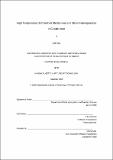High temperature deformation mechanisms and strain heterogeneities in calcite rocks
Author(s)
Xu, Lili, Sh. D. Massachusetts Institute of Technology
DownloadFull printable version (52.47Mb)
Other Contributors
Massachusetts Institute of Technology. Dept. of Earth, Atmospheric, and Planetary Sciences.
Advisor
J. Brian Evans.
Terms of use
Metadata
Show full item recordAbstract
In nature, carbonates often accumulate large amounts of strain in localized shear zones. Such marble sequences play a key role in crustal deformation processes. Despite extensive field and laboratory investigation, many questions remain concerning the mechanical behavior of these rocks. For example, the mechanical behavior of different limestones and marbles differ greatly, possibly owing to the presence of chemical impurities or solid-solutes. Thus, Chapter 2 examines the effect of Mg solute, a common impurity, on the mechanical behavior of calcite rocks. The results indicate that increasing Mg content increases the strength of calcite rocks during dislocation creep. The anisotropic nature of crystal slip usually entails variations in reorientation of individual grains and heterogeneous deformation within the polycrystalline material. In Chapter 3, a new technique including a series of sample preparation and image analysis algorithms is developed to provide quantitative measurements of the scale of heterogeneities produced, and to gain fundamental insight into polycrystalline plasticity. We place particular attention on quantifying variations of strain within grain interiors and at grain boundaries, and on recognizing the relative activities of different slip systems. The quantification of grain-to-grain interactions during straining is relevant for the improvement and verification of models of polycrystalline plasticity. The strain measurements obtained from Chapter 3 are compared with predictions of grain strain and reorientation obtained from the self-consistent viscoplastic method (Chapter 4). The results suggest that the self-consistent model gives a good description of global texture, but does not always predict lattice rotation and deformation within individual grains. To predict the actual deformation of individual grains will require a quantitative consideration of the effects on local strain of grain-boundary misorientation, local strain/stress state, grain-boundary sliding, and deviations in grain geometry.
Description
Thesis (Ph. D.)--Massachusetts Institute of Technology, Dept. of Earth, Atmospheric, and Planetary Sciences, 2008. This electronic version was submitted by the student author. The certified thesis is available in the Institute Archives and Special Collections. Page 238 blank. Includes bibliographical references.
Date issued
2008Department
Massachusetts Institute of Technology. Department of Earth, Atmospheric, and Planetary SciencesPublisher
Massachusetts Institute of Technology
Keywords
Earth, Atmospheric, and Planetary Sciences.